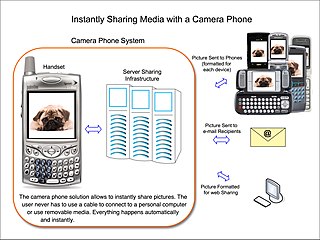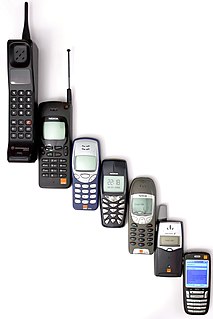Related Research Articles

Advanced Mobile Phone System (AMPS) was an analog mobile phone system standard originally developed by Bell Labs and later modified in a cooperative effort between Bell Labs and Motorola. It was officially introduced in the Americas on October 13, 1983, Israel in 1986, Australia in 1987, Singapore in 1988, and Pakistan in 1990. It was the primary analog mobile phone system in North America through the 1980s and into the 2000s. As of February 18, 2008, carriers in the United States were no longer required to support AMPS and companies such as AT&T and Verizon Communications have discontinued this service permanently. AMPS was discontinued in Australia in September 2000, in Pakistan by October 2004, in Israel by January 2010, and Brazil by 2010.

Dziga Vertov was a Soviet pioneer documentary film and newsreel director, as well as a cinema theorist. His filming practices and theories influenced the cinéma vérité style of documentary movie-making and the Dziga Vertov Group, a radical film-making cooperative which was active from 1968 to 1972. He was a member of the Kinoks collective, with Elizaveta Svilova and Mikhail Kaufman.

Man with a Movie Camera is an experimental 1929 Soviet silent documentary film, directed by Dziga Vertov, filmed by his brother Mikhail Kaufman, and edited by his wife Yelizaveta Svilova. Kaufman also appears as the eponymous Man of the film.

In Japan, mobile phones became ubiquitous years before the phenomenon spread worldwide. In Japanese, mobile phones are called keitai denwa (携帯電話), literally "portable telephones," and are often known simply as keitai.

A cell site, cell tower, or cellular base station is a cellular-enabled mobile device site where antennas and electronic communications equipment are placed—typically on a radio mast, tower, or other raised structure—to create a cell in a cellular network. The raised structure typically supports antenna and one or more sets of transmitter/receivers transceivers, digital signal processors, control electronics, a GPS receiver for timing, primary and backup electrical power sources, and sheltering.

A camera phone is a mobile phone which is able to capture photographs and often record video using one or more built-in digital cameras. It can also send the resulting image wirelessly and conveniently. The first color commercial camera phone was the Kyocera Visual Phone VP-210, released in Japan in May 1999.

A cellular network or mobile network is a communication network where the link to and from end nodes is wireless. The network is distributed over land areas called "cells", each served by at least one fixed-location transceiver. These base stations provide the cell with the network coverage which can be used for transmission of voice, data, and other types of content. A cell typically uses a different set of frequencies from neighboring cells, to avoid interference and provide guaranteed service quality within each cell.
A landline is a phone that uses a metal wire or optical fiber telephone line for transmission as distinguished from a mobile cellular network, which uses radio waves for transmission.
GSM frequency bands or frequency ranges are the cellular frequencies designated by the ITU for the operation of GSM mobile phones and other mobile devices.

Mobile telephony is the provision of telephone services to phones which may move around freely rather than stay fixed in one location. Telephony is supposed to specifically point to a voice-only service or connection, though sometimes the line may blur.

The history of mobile phones covers mobile communication devices that connect wirelessly to the public switched telephone network.

Martin "Marty" Cooper is an American engineer. He is a pioneer in the wireless communications industry, especially in radio spectrum management, with eleven patents in the field.
Soviet montage theory is an approach to understanding and creating cinema that relies heavily upon editing. It is the principal contribution of Soviet film theorists to global cinema, and brought formalism to bear on filmmaking.
A cell phone novel, or mobile phone novel, is a literary work originally written on a cellular phone via text messaging. This type of literature originated in Japan, where it has become a popular literary genre. However, its popularity has also spread to other countries internationally, especially to China, United States, Germany, and South Africa. Chapters usually consist of about 70–100 words each due to character limitations on cell phones.
Documentary practice is the process of creating documentary projects. It refers to what people do with media devices, content, form, and production strategies in order to address the creative, ethical, and conceptual problems and choices that arise as they make documentary films or other similar presentations based on fact or reality. Colleges and universities offer courses and programs in documentary practice.

A mobile phone, cellular phone, cell phone, cellphone, handphone, or hand phone, sometimes shortened to simply mobile, cell or just phone, is a portable telephone that can make and receive calls over a radio frequency link while the user is moving within a telephone service area. The radio frequency link establishes a connection to the switching systems of a mobile phone operator, which provides access to the public switched telephone network (PSTN). Modern mobile telephone services use a cellular network architecture and, therefore, mobile telephones are called cellular telephones or cell phones in North America. In addition to telephony, digital mobile phones (2G) support a variety of other services, such as text messaging, MMS, email, Internet access, short-range wireless communications, business applications, video games and digital photography. Mobile phones offering only those capabilities are known as feature phones; mobile phones which offer greatly advanced computing capabilities are referred to as smartphones.

New Horizons Film Festival is an international film festival held annually in July in Wrocław, Poland. It has been organised since 2001. It is one of the biggest and most popular film festivals in Poland. Since 2008 it is accredited by FIAPF with an "avant-garde" specialised competitive status.

MasterImage 3D is a company that develops stereoscopic 3D systems for theaters, and auto-stereoscopic 3D displays for mobile devices.

The Image Book is a 2018 Swiss avant-garde essay film directed by Jean-Luc Godard. Initially titled Tentative de bleu and Image et parole, in December 2016 Wild Bunch co-chief Vincent Maraval stated that Godard had been shooting the film for almost two years "in various Arab countries, including Tunisia" and that it is an examination of the modern Arabic world. Godard told Séance magazine that he was shooting without actors but the film would have a storyteller. It was selected to compete for the Palme d'Or at the 2018 Cannes Film Festival. Although it did not win the official prize, the jury awarded it the first "Special Palme d'Or" in the festival's history. According to Godard, the film is intended to be shown on TV screens with speakers at a distance, in small spaces rather than in regular cinemas. It was shown in this way during its first run at the Théâtre Vidy-Lausanne in November 2018.

The Sony Xperia 1 is an Android smartphone manufactured and marketed by Sony. Part of Sony's flagship Xperia series, the device was announced to the public at a press conference held at the annual 2019 Mobile World Congress event on February 25, 2019. It is the world's first smartphone with an ultrawide 21:9 aspect ratio 4K HDR OLED display, dubbed CinemaWide, and Sony's first triple lens camera system featuring Eye AF eye-tracking technology seen in the company's Alpha line of professional-grade cameras. The Xperia 1 was later joined by a more compact variant, the Xperia 5, which was revealed on 5 September 2019. Compared to the Xperia 1, the Xperia 5 has a smaller 1080p screen, a smaller battery and a non-centrally aligned camera module.